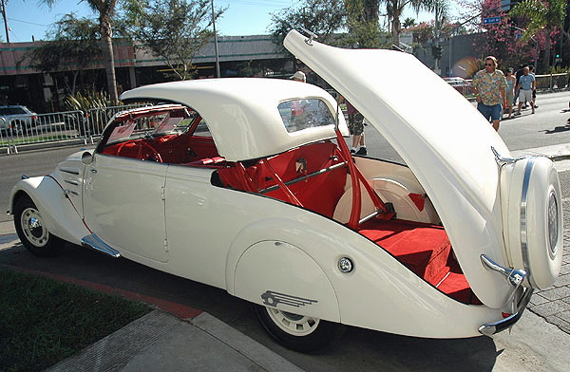
The French make Peugeot pioneered the retractable hardtop in the early 1930 ties by selling Éclipse bodies, made by coachbuilder Marcel Pourtout, on their 301 and 601 chassis. The concept of the Peugeot 402 Éclipse was also based on Georges Paulin’s patent. But this model, introduced in October 1935, was built in Peugeot’s own factory. Between 1936 and 1940 some 580 units were produced.
In the next three weeks, Gijsbert Paul Berk will detail the lives of three important Frenchman who had a tremendous influence on automobile design: Georges Paulin, Marcel Pourtout and Emile Darl’mat, the three Musketeers. Much of their combined work evolved around the development of the disappearing hardtop as conceived by Georges Paulin. To give us a further insight into how clever kinematics conquered the auto industry, Gijsbert-Paul sent us this history.
By Gijsbert-Paul Berk
In the previous decades nearly all the major car manufacturers have introduced retractable hardtops in their popular or premium convertible models.
Opel had them on the Tigra TwinTop, Ford on their Fiesta and Focus models, Renault provided a glass paneled ‘see through’ hard top on the Megane CC, Volvo on the C 70 and BMW on the type 4 cabriolet. There even exist Ferrari California and Ferrari 458 Italia Spider versions with a retractable top.
However, the offer of convertibles with a retractable hardtop is shrinking. This is has a number of reasons. The economic crisis caused the disappearance of specialized suppliers like Heuliez in France and Karmann in Germany. The same economic circumstances increased the necessity for car manufacturers to rationalize the production capacity of their factories and concentrate their efforts on more profitable models, such as small SUV’s. Part of their argument is that the market share of the cabriolet with a retractable top was always rather limited. Because of their price supplement and the fact that a folded steel top in the trunk generally takes up more space than a (cheaper) folded soft-top. And don’t forget that nowadays the costumer does not always get what he wants. In most cases it is what politicians and the marketing managers in the industry believe the public needs.

George Paulin's Eclipse construction was not the first retractable hardtop. In 1922 Ben P. Ellerbeck in the US had already build a manually operated ‘shiftable top' on a 1919 Hudson. His hardtop moved over the outside of the luggage compartment (trunk) at the rear of the two-seater body and thus did not limit the luggage capacity, even with the top down. However, Ellenbeck’s idea was never commercialized on a production car.
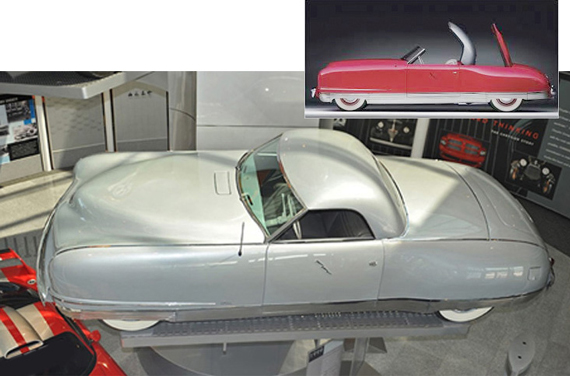
The Thunderbolt concept cars, presented in 1941 by Chrysler, were designed by Alex Tremulis (who then worked for automotive supplier Briggs). The cars had a full wide body, made from aluminum by LeBaron. The front wheels were hidden by the massive fenders, the headlamps concealed behind retractable panels and instead of using door handles the doors were hydraulically opened by pushing on a button. But what most surprised the American public at the time was the electrically operated retractable hardtop that completely disappeared into the trunk. Each of the six Thunderbolts produced, had its own unique color scheme.

At the 1955 Salon de l’Automobile in Paris, Ed and Jim Gaylord, two wealthy car enthusiasts from Chicago, unveiled a prototype of their Gaylord 'Gladiator'. It was a design by Brooks Stevens, who later created the 'neo-classical' Excalibur cars. The Gladiator had a retractable hardtop and the spare tire slid out on a tray from the rear of the vehicle. The Gaylords intended the bodies to be constructed by the Zeppelin Company in Freidreichshaven, Germany. They counted to receive 25 orders at the Paris Show but this proved to be too optimistic. Only 3 pre-production cars were produced.
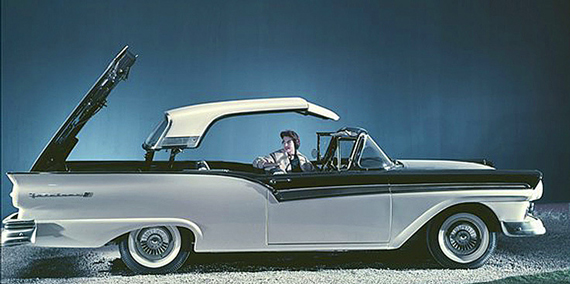
As part of their 1957 model range, Ford introduced the Fairlane 500 Skyliner. It was the first American production car with a retractable hardtop. Its complex mechanism which first folded the front of the of the roof and ad then retracted it under the rear deck lid, needed a total of 610 ft. (185.9 m) of extra wiring. Contrary what many feared, the mechanism worked well and proved to be reasonably reliable. But the folded hardtop in the trunk took up too much luggage space, limiting the Skyliner's sales appeal. These Ford convertibles were made in the US from 1957 till 1959 and production totaled 48,394 units. (There would be a noticeable gap in the development of the disappearing hardtop from 1965 to 1990 as car manufacturers struggled instead with safety and emissions.)
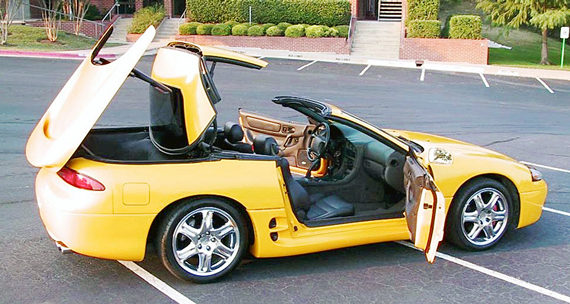
During the early 1990s, Heinz Prechter, the president of the American Sunroof Company (ASC), convinced the Japanese carmaker Mitsubishi to equip the 3000GT sports coupé with a retractable hardtop. In 1994 Mitsubishi introduced its 3000GT Spyder, as this version was called. The roof moving mechanism resembled that of Ford’s Skyliner, but Mitsubishi’s ASC system was controlled by a computer chip. This made it capable of raising or lowering the roof in only 19 seconds. However, the whole system added some 300-pound (136 kg) to the weight of this sporting two-seater, which handicapped its performance. In the two years it was produced only 1,034 units were sold. But the 3000GT Spyder certainly enhanced the corporate image of Mitsubishi as a state-of-the-art automobile manufacturer.
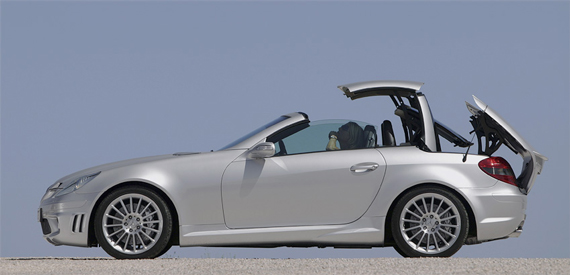
The sporting Mercedes–Benz SLK with its retractable ‘Vario roof’ was first shown as a concept car at the 1994 Paris Motor Show. It was designed by Murat Gunak and Micheal Mauer. SLK stands for “Sport, Leicht = Light, Kurtz = Short”. This compact roadster was manufactured by Mercedes in three generations; R170 launched in 1996, the R171 in 2004 and R172 in 2011. The folding steel ‘Vario roof’ top consists of two halves. These are connected by a kinematic mechanism, which for reasons of safety is firmly locked when the roof is closed. A hydraulic system stows the vario-roof into the trunk. With the roof stowed, the luggage capacity is 145 liters (5,12 cu ft) but when the roof is closed, this increases to 348 liters (12.3 cu ft.). Two fixed roll bars behind the seats and strong A-pillars in combination with the steel hardtop provide a high degree of accident protection. The SLK was produced in Bremen, Germany and in East London, South Africa.
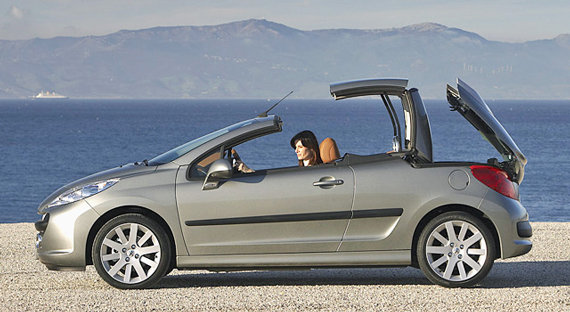
In October 2000 Peugeot launched its 206 CC (for Coupé Cabriolet). This small two-seater was based on the mechanical parts of the very popular four door Peugeot 206 hatchback, but featured a powered retractable roof, reminiscent of the system of Georges Paulin as used on the 1935 Peugeot 402 Éclipse Coupé. The 205 CC and its successor the 207 CC were produced for Peugeot by coachwork specialist Heuliez in Cerzay, France.

After Peugeot extended its range with the larger 307 hatchback and Station Wagon models it also added a 307 CC. The 307 CC, that also was fitted with a retractable hardtop and could seat four, was available from 2003 and was in 2007 replaced by the largely similar but in many details improved 308 CC. The roof could now be lowered in only 20 seconds, and at up to speeds of 7.5 mph (12.1 km/h). But with the hardtop stowed in the luggage compartment its capacity shrank from 465 liters to 266 liters.
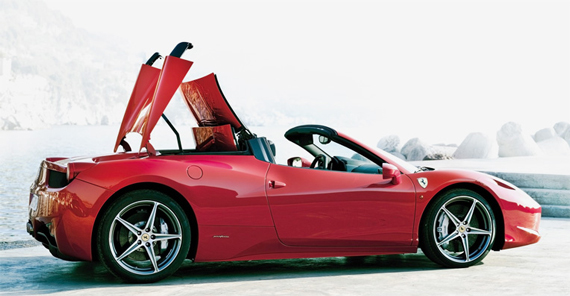
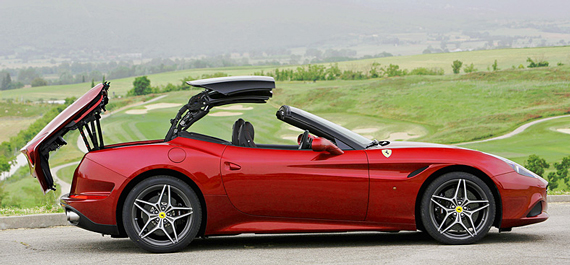
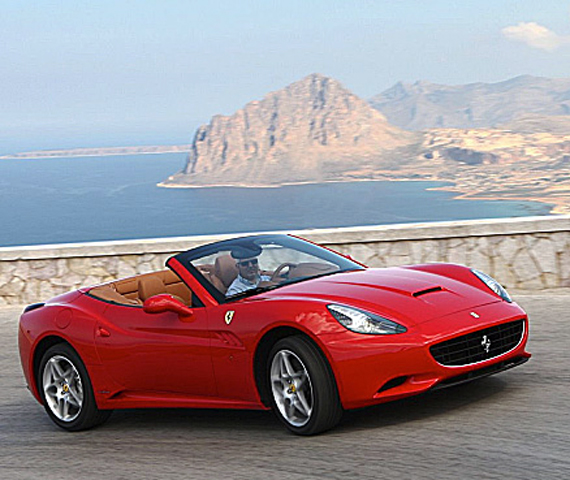
the prototype roof of the Peugeot 206CC was developed by Heuliez on the INTRUDER, a SUV on Mercedes G Klass short wheel base off road with a retractable roof.
The car bought at the Heuliez sale is being restored and made fully functional and will be finished by year end…
Merci de l’info : pour voir les photos de cette Intruder SWB, voici un lien:
http://oldconceptcars.com/1930-2004/mercedes-benz-heuliez-intruder-concept-1996/
Hervé